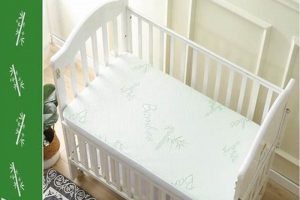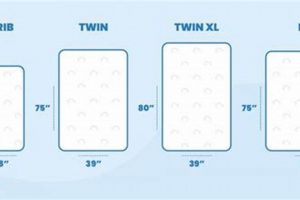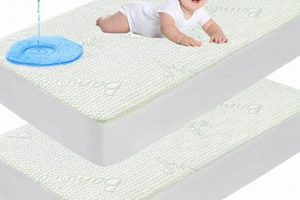A sleep surface for infants, constructed with materials certified as organic and designed to fit within a crib frame, aims to minimize exposure to synthetic chemicals. This type of mattress typically utilizes organic cotton, wool, or natural latex as primary components, contrasting with conventional mattresses that may incorporate polyurethane foam or chemical flame retardants.
The perceived value lies in providing a potentially healthier sleep environment for babies, reducing the risk of exposure to volatile organic compounds (VOCs) and other substances linked to potential health concerns. Historically, parents have sought safer and more natural products for their children, driving the demand for certifications like GOTS (Global Organic Textile Standard) and GOLS (Global Organic Latex Standard) as indicators of material purity and responsible manufacturing practices.
The following sections will delve into the characteristics that define a high-quality option, covering material composition, certification verification, safety standards, and factors to consider when selecting the appropriate sleep surface for an infant’s crib.
Selecting a Superior Organic Infant Bedding
Evaluating infant bedding requires careful consideration of safety standards and material composition. Prioritize certified products to ensure minimal exposure to harmful chemicals.
Tip 1: Verify Certification: Confirm that the mattress carries reputable certifications like GOTS (Global Organic Textile Standard) or GOLS (Global Organic Latex Standard). These indicate third-party verification of organic material content and manufacturing processes.
Tip 2: Assess Material Composition: Scrutinize the materials list. Opt for mattresses primarily composed of organic cotton, wool, or natural latex. Avoid polyurethane foam and chemical flame retardants.
Tip 3: Evaluate Flame Retardancy: Understand how flame retardancy is achieved. Natural wool can act as a flame barrier. Ensure any applied treatments are non-toxic and meet federal safety standards.
Tip 4: Consider Firmness: Infants require a firm sleep surface. Ensure the mattress provides adequate support to reduce the risk of suffocation.
Tip 5: Check for VOC Emissions: Look for certifications like GREENGUARD Gold, which indicates low volatile organic compound (VOC) emissions, promoting better air quality.
Tip 6: Research Company Reputation: Investigate the manufacturer’s history and commitment to ethical and sustainable practices.
Tip 7: Review Warranty and Return Policy: A reasonable warranty and return policy provide recourse in case of defects or dissatisfaction.
Prioritizing certifications, material transparency, and safety standards will ensure a healthier sleep environment for the infant. Careful selection mitigates potential exposure to harmful chemicals and promotes overall well-being.
The final section of this article provides concluding remarks on the importance of informed consumer choices in infant bedding.
1. Material Certification Verification
Material certification verification serves as a cornerstone in determining the legitimacy and safety of an organic infant sleep surface. Certifications like GOTS (Global Organic Textile Standard) and GOLS (Global Organic Latex Standard) provide documented assurance that the materials used in the mattress meet specific organic standards throughout the entire supply chain, from raw material sourcing to manufacturing and distribution. The presence of these certifications signifies that independent third-party organizations have assessed the product and confirmed its compliance with rigorous criteria. This verification process reduces the risk of “greenwashing,” where manufacturers falsely claim organic properties for marketing purposes. For example, a mattress claiming to use organic cotton, but lacking GOTS certification, may contain conventionally grown cotton treated with pesticides and chemicals during processing.
The absence of proper certification renders the organic label questionable. Consider the scenario where an infant mattress is marketed as natural latex but lacks GOLS certification. This suggests the latex could be synthetic, blended with synthetic materials, or processed with chemicals not permitted under organic standards. Furthermore, material certification verification often encompasses testing for harmful substances like phthalates, heavy metals, and VOCs, providing an additional layer of safety assurance for the infant. A certified product demonstrates a commitment to both environmental responsibility and the well-being of the child, as evidenced by traceable and verifiable processes. Conversely, reliance on unverified claims introduces significant uncertainty and potential exposure to undesirable materials.
In summary, material certification verification is not merely a marketing attribute but a fundamental requirement for a truly organic infant sleep surface. It mitigates risks associated with misleading claims, ensures adherence to established organic standards, and promotes a healthier sleep environment for infants. Consumers should prioritize mattresses bearing reputable certifications as a primary factor in their selection process, recognizing this as a tangible safeguard against potentially harmful materials and practices.
2. Firmness and Support
The attributes of firmness and support are paramount considerations in the selection of an infant mattress, particularly within the context of organically constructed options. These factors directly impact the infant’s safety and musculoskeletal development, necessitating a thorough understanding of their implications.
- Sudden Infant Death Syndrome (SIDS) Risk Reduction
A firm sleep surface is consistently recommended by pediatricians to mitigate the risk of SIDS. A too-soft mattress can conform to the infant’s face, potentially obstructing airways and leading to suffocation. Organic materials, while beneficial in terms of chemical exposure, must still provide adequate firmness to meet safety standards. The composition must maintain its structural integrity throughout its lifespan, preventing indentation or sagging.
- Spinal Development and Posture
Infants’ spines require appropriate support for healthy development. An overly soft mattress can disrupt spinal alignment, potentially leading to musculoskeletal issues later in life. A firm mattress provides a stable foundation that promotes proper posture and reduces strain on developing muscles. The mattress must distribute the infant’s weight evenly, preventing pressure points and ensuring consistent support across the entire surface.
- Material Density and Construction
The firmness of an mattress is directly related to the density and construction of its materials. Organic cotton, wool, and natural latex each possess unique properties that affect firmness. A mattress constructed with tightly packed, high-density materials will generally provide greater support than one made with loosely packed or low-density materials. The internal layering and quilting also contribute to the overall firmness and must be engineered to meet safety and support requirements.
- Compliance with Safety Standards
Recognized safety standards, such as those established by the Consumer Product Safety Commission (CPSC), specify minimum firmness requirements for infant mattresses. Manufacturers of mattresses must adhere to these standards to ensure their products are safe for infant use. Documentation of compliance with these standards, including relevant testing reports, provides assurance that the mattress meets established safety criteria, regardless of its organic composition.
The selection of an “best organic crib mattress” requires a balance between minimizing exposure to potentially harmful chemicals and ensuring adequate firmness and support for infant safety and development. Prioritizing mattresses that meet established safety standards, regardless of material composition, is crucial. Consumers must scrutinize product specifications and certifications to make informed decisions that prioritize both health and safety.
3. Chemical Flame Retardants
The presence or absence of chemical flame retardants is a critical differentiator in the selection of an infant sleep surface. Conventional mattresses often incorporate these chemicals to meet flammability standards, whereas mattresses categorized as “best organic crib mattress” actively seek to avoid them. The rationale centers on potential health risks associated with certain flame retardant chemicals. Studies have linked some of these substances to endocrine disruption, neurodevelopmental issues, and even cancer. Infants are particularly vulnerable due to their developing systems and increased exposure through inhalation and ingestion.
The exclusion of chemical flame retardants in a genuinely organic infant mattress necessitates alternative approaches to meet flammability requirements. Natural materials such as wool act as inherent flame barriers, providing a safer, non-toxic solution. Mattress manufacturers may also utilize tightly woven fabrics and specific construction techniques to reduce flammability. It is imperative to verify that a mattress claiming to be free of chemical flame retardants provides documented evidence of compliance with safety regulations. For instance, a mattress using wool as a flame barrier should possess certification confirming the wool’s purity and effectiveness in meeting flammability standards without the addition of chemicals. Failure to adequately address flammability through safe, alternative methods compromises infant safety.
In conclusion, the absence of chemical flame retardants is a defining characteristic of a high-quality organic infant sleep surface. However, it is crucial to ensure that this absence is coupled with alternative measures that effectively meet flammability standards. Consumers must prioritize verification of these alternative methods through certifications and documentation to guarantee both the safety and the non-toxic nature of the mattress. The decision to choose an mattress without chemical flame retardants should be accompanied by diligent research and a commitment to verifying claims made by manufacturers.
4. VOC Emissions
Volatile Organic Compounds (VOCs) are gases emitted from various solids and liquids, many of which can have adverse health effects. The connection between VOC emissions and “best organic crib mattress” is paramount because conventional mattresses often contain materials, such as polyurethane foam and chemical adhesives, that release VOCs. An mattress marketed as best organic crib mattress aims to minimize or eliminate these emissions by utilizing natural and certified organic materials like organic cotton, wool, and natural latex. For example, a conventional mattress might release formaldehyde, a known carcinogen, while a mattress bearing certifications such as GREENGUARD Gold ensures it has been tested and shown to have low VOC emissions, thereby reducing the infant’s exposure to potentially harmful chemicals. The importance of minimizing VOC emissions in a mattress stems from the infant’s prolonged exposure during sleep and the potential impact on respiratory health and overall development.
The selection of an mattress that minimizes VOC emissions has practical implications for improving indoor air quality. Infants spend a significant portion of their early lives sleeping, making the mattress a primary source of potential VOC exposure. Lowering VOC levels within the infant’s sleep environment can translate to decreased risks of respiratory irritation, allergies, and other health complications. For instance, parents choosing mattresses with GREENGUARD Gold certification often report a noticeable reduction in chemical odors, contributing to a more comfortable and healthier sleep environment for their children. Independent testing and certification provide consumers with verifiable data regarding a mattress’s VOC emission levels, enabling informed decision-making. This approach contrasts with relying solely on manufacturer claims without third-party validation.
In summary, VOC emissions are a significant factor in determining the safety and suitability of an mattress. By prioritizing mattresses that utilize organic and natural materials and undergo rigorous VOC emission testing, consumers can create a healthier sleep environment for infants. The challenge lies in identifying and verifying credible certifications that accurately reflect a mattress’s VOC emission levels. Selecting mattresses based on these standards aligns with the broader goal of minimizing chemical exposure during early development and promoting long-term health outcomes.
5. Manufacturer Transparency
Manufacturer transparency is a fundamental aspect in evaluating the quality and integrity of a “best organic crib mattress.” It encompasses the manufacturer’s willingness to openly share information regarding sourcing, materials, manufacturing processes, and certifications. The absence of transparency raises concerns about potential hidden costs, unethical labor practices, and the veracity of organic claims.
- Supply Chain Traceability
Traceability refers to the ability to track the origin and journey of materials used in mattress production. A transparent manufacturer provides detailed information about the sources of organic cotton, wool, or natural latex, including farm locations and processing facilities. This allows for verification of ethical sourcing and adherence to organic farming practices. Lack of traceability obscures the potential for exploitation of workers or the use of non-organic materials falsely labeled as such.
- Material Composition Disclosure
Full disclosure of all materials used in the mattress, including those present in small quantities, is essential. Transparent manufacturers provide detailed lists of components and their respective certifications. This enables consumers to assess the potential for allergens or sensitivities to specific materials. Ambiguous or incomplete material lists raise red flags about the potential inclusion of undisclosed synthetic chemicals or non-organic components.
- Manufacturing Process Information
Transparency extends to the manufacturing processes employed, including details about chemical treatments, flame retardant methods (if any), and waste management practices. A manufacturer committed to transparency will readily provide information about these processes and demonstrate adherence to environmental and ethical standards. Lack of clarity about manufacturing processes suggests the potential for environmentally harmful practices or the use of undisclosed chemicals.
- Independent Certification Verification
Transparent manufacturers readily provide access to independent certification documentation from organizations like GOTS, GOLS, or GREENGUARD. This verification allows consumers to confirm that claims of organic content and low VOC emissions are substantiated by third-party assessments. Reluctance to provide certification documentation casts doubt on the validity of product claims and the manufacturer’s commitment to transparency.
Manufacturer transparency serves as a crucial indicator of product quality and ethical business practices. By prioritizing mattresses from manufacturers who readily share information about sourcing, materials, and processes, consumers can make informed choices that align with their values and promote a healthier sleep environment for infants. The alternative relying on opaque claims and unsubstantiated promises introduces significant risks and undermines the purpose of selecting a supposedly “best organic crib mattress.”
Frequently Asked Questions
This section addresses common inquiries and concerns regarding the selection and use of organic infant sleep surfaces, providing factual information to aid in informed decision-making.
Question 1: What constitutes a genuinely “organic” mattress?
A genuinely organic mattress is constructed primarily from certified organic materials, such as cotton, wool, or natural latex, and manufactured without the use of harmful chemicals, adhesives, or flame retardants. Third-party certifications, like GOTS or GOLS, provide verification of these standards.
Question 2: Are mattresses without chemical flame retardants safe for infants?
Mattresses lacking chemical flame retardants can be safe if they utilize alternative methods to meet flammability standards, such as the incorporation of natural wool or specific mattress construction techniques. Verification of compliance with federal flammability regulations is essential.
Question 3: How can one verify the organic claims made by manufacturers?
Organic claims should be substantiated by reputable third-party certifications. Consumers should request documentation from the manufacturer demonstrating compliance with specific organic standards, such as GOTS or GOLS.
Question 4: Is a mattress more expensive than a conventional one?
Generally, mattresses utilizing certified organic materials and adhering to stringent manufacturing standards carry a higher price point compared to conventional counterparts. This reflects the increased cost of organic materials and ethical production practices.
Question 5: What level of firmness is appropriate for an mattress?
Infants require a firm sleep surface to minimize the risk of Sudden Infant Death Syndrome (SIDS). The mattress should provide adequate support and prevent the formation of indentations that could obstruct the infant’s airway.
Question 6: How often should an infant mattress be replaced?
Infant mattresses should be replaced if they exhibit signs of wear and tear, such as sagging, indentations, or compromised structural integrity. It is recommended to replace a used mattress with a new one for each infant to ensure optimal hygiene and support.
The above answers provide foundational guidance for navigating the complexities of mattress selection. Prioritizing verified certifications and verifiable safety standards ensures the well-being of the infant.
The concluding section of this discussion offers a synthesis of key considerations and emphasizes the importance of informed consumer choice in infant sleep environments.
Informed Selection of the “Best Organic Crib Mattress”
This exploration has dissected the critical attributes defining a high-quality infant sleep surface. From material certification verification to the avoidance of chemical flame retardants and the minimization of VOC emissions, the multifaceted criteria for selecting an appropriate sleep environment have been presented. The significance of manufacturer transparency and the necessity of ensuring adequate firmness and support have been emphasized as essential components of a well-informed purchasing decision.
The selection of an appropriate infant sleep surface demands diligence and a commitment to scrutinizing manufacturer claims. Given the potential impact on infant health and development, prioritizing verified certifications, comprehensive material disclosure, and adherence to established safety standards remains paramount. The informed selection represents an investment in the well-being of the child, underscoring the gravity of this decision.







